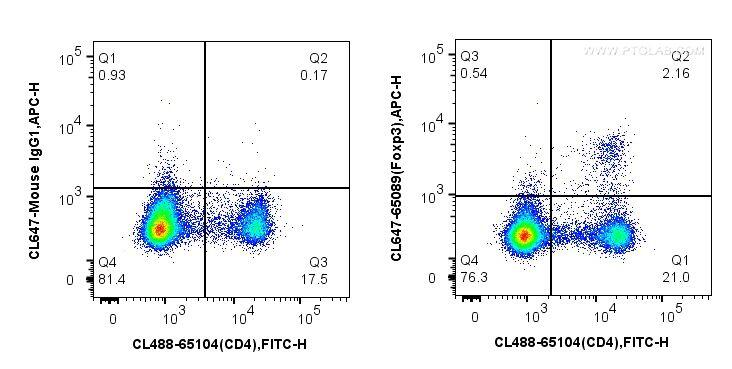- Phare
- Validé par KD/KO
Anticorps Monoclonal anti-FUS/TLS
FUS/TLS Monoclonal Antibody for FC (Intra), IF
Hôte / Isotype
Mouse / IgG1
Réactivité testée
Humain, souris
Applications
IF, FC (Intra)
Conjugaison
CoraLite® Plus 488 Fluorescent Dye
CloneNo.
3A10B5
N° de cat : CL488-60160
Synonymes
Galerie de données de validation
Applications testées
| Résultats positifs en IF | cellules HeLa, |
| Résultats positifs en cytométrie | cellules K-562, |
Dilution recommandée
| Application | Dilution |
|---|---|
| Immunofluorescence (IF) | IF : 1:50-1:500 |
| Flow Cytometry (FC) | FC : 0.20 ug per 10^6 cells in a 100 µl suspension |
| It is recommended that this reagent should be titrated in each testing system to obtain optimal results. | |
| Sample-dependent, check data in validation data gallery | |
Informations sur le produit
CL488-60160 cible FUS/TLS dans les applications de IF, FC (Intra) et montre une réactivité avec des échantillons Humain, souris
| Réactivité | Humain, souris |
| Hôte / Isotype | Mouse / IgG1 |
| Clonalité | Monoclonal |
| Type | Anticorps |
| Immunogène | FUS/TLS Protéine recombinante Ag2150 |
| Nom complet | fusion (involved in t(12;16) in malignant liposarcoma) |
| Masse moléculaire calculée | 75 kDa |
| Poids moléculaire observé | 75 kDa |
| Numéro d’acquisition GenBank | BC026062 |
| Symbole du gène | FUS |
| Identification du gène (NCBI) | 2521 |
| Conjugaison | CoraLite® Plus 488 Fluorescent Dye |
| Excitation/Emission maxima wavelengths | 493 nm / 522 nm |
| Forme | Liquide |
| Méthode de purification | Purification par protéine G |
| Tampon de stockage | PBS avec glycérol à 50 %, Proclin300 à 0,05 % et BSA à 0,5 %, pH 7,3. |
| Conditions de stockage | Stocker à -20 °C. Éviter toute exposition à la lumière. Stable pendant un an après l'expédition. L'aliquotage n'est pas nécessaire pour le stockage à -20oC Les 20ul contiennent 0,1% de BSA. |
Informations générales
FUS (also named TLS and POMp75) belongs to the RRM TET family. FUS may play a role in the maintenance of genomic integrity; it binds both single-stranded and double-stranded DNA and promotes ATP-independent annealing of complementary single-stranded DNAs and D-loop formation in superhelical double-stranded DNA. FUS is also an RNA-binding protein, and its links to neurodegenerative disease proffer the intriguing possibility that altered RNA metabolism or RNA processing may underlie or contribute to neuron degeneration. Two research groups simultaneously reported that FUS is present in 5% of the pathalogical aggregations (inclusions) seen in familial amyotrophic sclerosis (fALS). FUS-positive inclusions were also reported in cases of sporadic ALS (sALS). More recently, wild-type FUS has also been implicated in the pathological development of frototemporal lobar dementia (FTLD) with ubiquitin-positive inclusions (FTLD-U), further linking FUS to the pathogenesis of neurogenerative diseases. There is some debate as to whether FUS colocalizes with TDP-43 in TDP-43-positive cases of ALS and whether TDP-43 and FUS cause neurodegenerative disease independently or contributively of one another. This antibody is a mouse monoclonal antibody raised against an internal region of human FUS. Initial reports from our customers suggest this new monoclonal FUS antibody (60160-1-Ig) is a useful tool in ALS and FTLD research. For more details, please see our blog article regarding the matter.
Protocole
| Product Specific Protocols | |
|---|---|
| IF protocol for CL Plus 488 FUS/TLS antibody CL488-60160 | Download protocol |
| Standard Protocols | |
|---|---|
| Click here to view our Standard Protocols |




